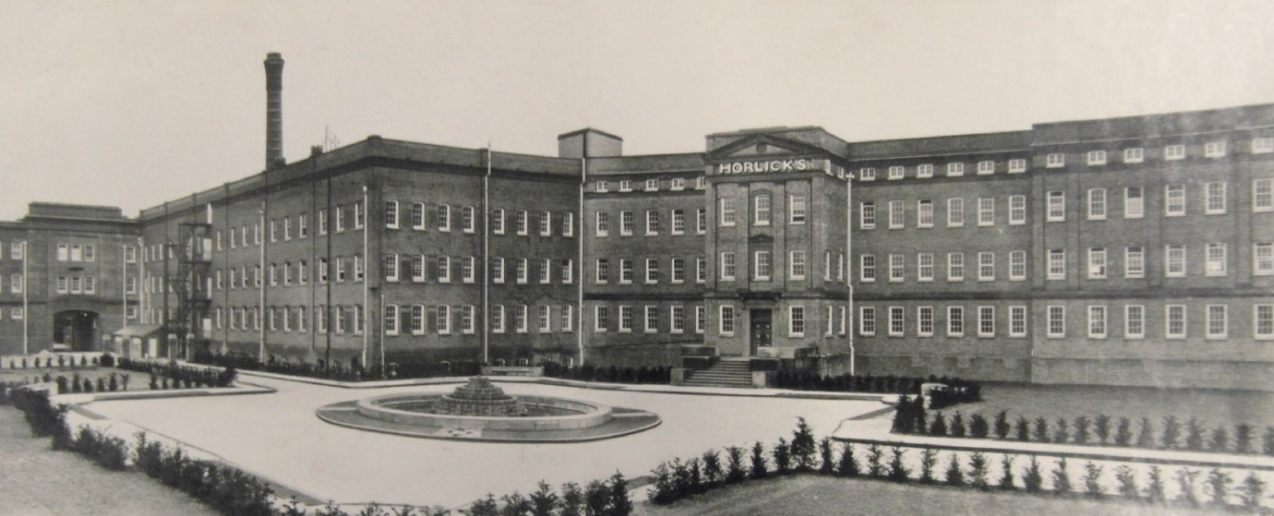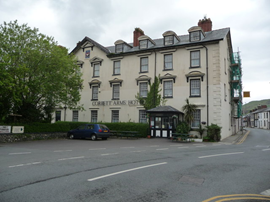A new purpose for the Horlicks Factory
Planning permission was granted in 2020 for a scheme that will reinstate the Horlicks Factory as a local landmark in Slough, celebrating the area’s industrial past and the history of the product.

|
| The Horlicks Factory in around 1930. |
Only a select few products can truly claim to be iconic, but Horlicks, the eponymous sweet malted drink is, arguably, one of them. From its beginnings in Chicago in 1873, Horlicks’ pioneering use of vacuuming technology created a ‘food drink’ made from dried milk, malted wheat and barley. The company’s British headquarters, a large red-brick factory, was built in Slough in 1908, and Horlicks quickly became a household name that endured throughout the 20th century.
Today the name conjures up a range of associations. Some think of Horlicks tablets, which were included in army ration kits during the first and second world wars. Others may remember the, at best, questionable science behind the ‘night-starvation theory’ that was used to market the product in the 1950s. For many, it conjures up wholesome childhood memories of being brought a hot milky Horlicks in bed by a parent or grandparent. The Horlicks Company in Slough was economically and socially important, employing thousands of people over its 110-year operation. These are just some of the reasons why the Horlicks Factory is a local landmark and well-loved building.
When news spread of the imminent closure of the factory in 2017, the fate of the building was a cause for concern. The factory was locally listed in 1999 and the company’s own dedicated war memorial was listed at Grade II in 2017. The factory itself did not meet the requirements for statutory listing when the pair was assessed by Historic England in 2017. Luckily the factory was acquired by Berkeley Homes, which had the vision of designing a housing scheme on the site that focused on the main factory and celebrated its history. As the planning and heritage consultants, one of Lichfields’ roles was to identify what was significant about the buildings, the memorial and other features within the grounds, and to advise on how those features and their settings could be preserved and enhanced, while introducing a new use.
The historic factory was built in three main phases in 1908, 1929 and 1939. It has been extended and altered many times over the past century, but its key recognisable features have endured. The crenelated square clock tower with tourelles, the iconic red Horlicks sign fixed above the parapet (albeit a modern replacement) and the 47-metre-tall chimney. Particularly interesting features within the site include the listed war memorial, comprising a bronze sculpture of an angel in grief, designed by renowned artist William Reid Dick; the factory’s north main entrance, incorporating art-deco motifs; sidings that once connected to the main railway; and six covered-over artesian wells, originally used in the food manufacturing process.
Berkeley Homes was granted planning permission in March 2020 for the conversion of the Horlicks Factory into residential apartments, with a nursery and café at ground floor level, and a series of residential blocks within the factory grounds. The scheme, designed by Berkeley and architects Sheppard Robson, will preserve the clocktower, chimney and signage. The factory will remain a prominent landmark, visible from various parts of central Slough and from the railway when approaching Slough by train. For the first time the factory grounds will be publicly accessible, allowing local residents and visitors to appreciate and enjoy the history of the site.
Landscaping is an important part of the scheme, and new areas of public realm will be created around the historic and new buildings. The sidings will be retained and the war memorial is to be set within a new public square, designed by landscape architects Bradley Murphy Design. The aim is to realise the original design intention for the memorial and create a space that provides appropriate opportunities for refection and commemoration. Listed building consent to relocate the memorial, which currently sits in a sprawling car park, was granted along with the planning permission. This will strengthen the memorial’s relationship with the original factory entrance.
Adaptively reusing the vacant factory will ensure that this locally iconic building remains at the heart of Slough’s local community, contributing to the town’s identity and acting as a catalyst for further investment and regeneration. Quoting one of Horlicks’ original straplines, the Horlicks factory showcases how preserving and adapting redundant historic buildings can contribute to their local area by ‘Restoring energy and vitality’.
This article originally appeared in Context 165, published by The Institute of Historic Building Conservation in August 2020. It was written by Madeleine Rigby, a heritage consultant with Lichfields.
--Institute of Historic Building Conservation
Related articles on Designing Buildings Wiki
- Artesian.
- Billingsgate Market.
- Cambridge Market.
- Conservation.
- Heritage.
- IHBC articles.
- Incredible Edible Todmorden.
- Inntrepeneur Pub Company Ltd v. East Crown Ltd.
- Institute of Historic Building Conservation.
- Is Wandsworth the most pub friendly council.
- Listing of Sainsbury's supermarket in Camden Town.
- Significance and heritage protection at Cambridge Market.
- The changing face of the English pub.
- The Co-op: horse and cart to hypermarket.
- The decline and revival of food markets.
IHBC NewsBlog
Images from inside a Grade II listed hotel show the scale of its collapse
The Corbett Arms in Tywyn has fallen into serious disrepair.
Old Sarum fire in listed (& disputed) WW1 Hangar - Wiltshire Council has sought legal advice after fire engulfed a listed First World War hangar that was embroiled in a lengthy planning dispute.
UK Antarctic Heritage Trust launches ‘Virtual Visit’ website area
The Trust calls on people to 'Immerse yourself in our heritage – Making Antarctica Accessible'
Southend Council pledge to force Kursaal owners to maintain building
The Council has pledged to use ‘every tool in the toolbox’ if urgent repairs are not carried out.
HE’s Research Magazine publishes a major study of the heritage of England’s suburbs
The article traces the long evolution of an internal programme to research 200 years of suburban growth
IHBC Context 183 Wellbeing and Heritage published
The issue explores issues at the intersection of heritage and wellbeing.
SAVE celebrates 50 years of campaigning 1975-2025
SAVE Britain’s Heritage has announced events across the country to celebrate bringing new life to remarkable buildings.
IHBC Annual School 2025 - Shrewsbury 12-14 June
Themed Heritage in Context – Value: Plan: Change, join in-person or online.
200th Anniversary Celebration of the Modern Railway Planned
The Stockton & Darlington Railway opened on September 27, 1825.
Competence Framework Launched for Sustainability in the Built Environment
The Construction Industry Council (CIC) and the Edge have jointly published the framework.














